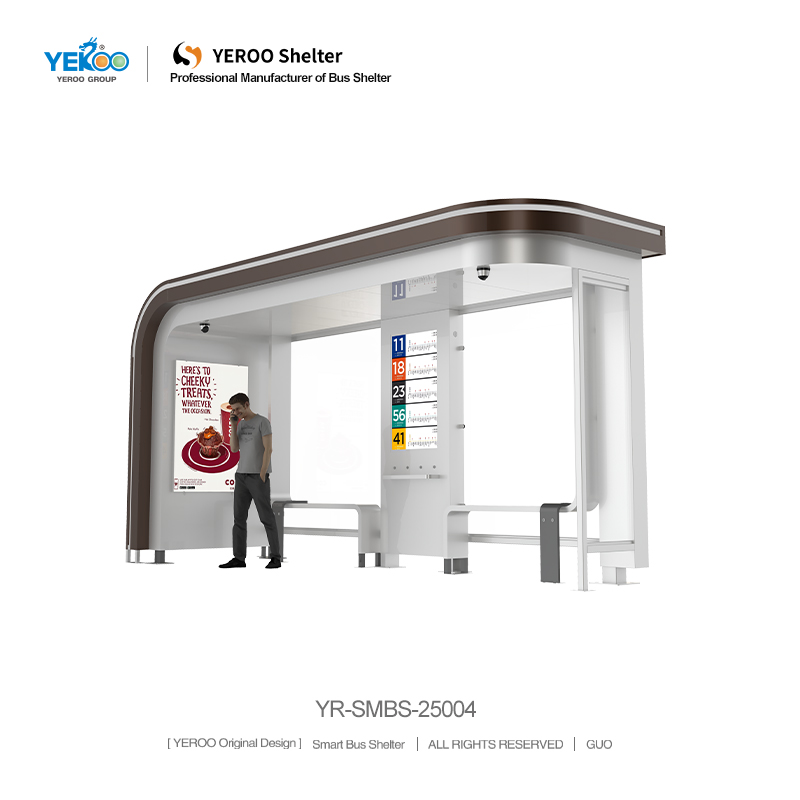X'inhuma l-Ivantaġġji tal-Ġġieża ta' Prefabbus għall-Fermata tal-Awtobus
L-adopzjoni ta’ paviljoni tal-bużu prefabbrikati ġiet opzjoni vijabbli fil-kuntest ta’ żvilupp rapids tal-infrastruttura urbana. Il-costruzzjoni ta’ paviljon tal-bużu prefabbrikat—fejn il-komponenti kollha jinħolqu f’fabbrika u jinbnew fuq il-post—tpermettilill-parti interesati li jaħlu sfidi bħal il-perjodu estensiv ta’ kostruzzjoni minħabba l-ħafna regolamenti u awtorizzazzjonijiet meħtieġa, il-bidliem spiss fl-ibbudjet oriġinali, u l-kwalità varjabbli li tintbagħat u timplimenta. Yeroo Group ( https://www.yeroogroup.com/), lider fil-qasam tal-prefabbrikazzjoni tal-infrastruttura pubblika, iżviluppa mudelli ta’ kwalità għolja ta’ paviljoni tal-bużu prefabbrikati li jikkorispondu bil-bżonnijiet tal-urbanizzazzjoni moderna. Hawn hekk il-benefiċċji prinċipali tal-għażla ta’ paviljon tal-bużu prefabbrikat.
Tnaqqis fit-Termini tal-Proġett permezz ta’ Installazzjoni Rapiża
Probabbilment l-iktar benefici importanti li jġibu l-kabina prefabbrikata għall-buż hija r-riduzzjoni drastika fit-temp li jinħaru fis-fażi tal-kostruzzjoni dibbiena għall-alternattivi tal-kabina. Il-komponenti kollha tal-kabina prefabbrikata għall-buż, inklużi l-frami, is-sukkien, il-kwinti u l-panelli, jintwżlu u jinbnew fil-fabbrika, li jbassar xogħol minimu li jibqa' limitat għal ġbir bażiku fuq il-post, li normalment ma jieħux iktar minn ftit sigħat sa jornata waħda. Ejempju, belt li tixtieq taġġorna malajr 10 kabina tat-trasport pubbliku. Tista’ tanżil il-kabina prefabbrikata għall-buż, u tibda tuża dawk it-10 kabina fl-għoli sebgħa, kontrast il-metodu tradizzjonali tal-kostruzzjoni li jista’ jieħu xahar minnu komuni.

L-assemblaġġ iktar malajr jnaqqas l-interruzzjonijiet fit-trasport pubbliku, jnaqqas it-traffiku madwar il-postijiet tal-kostruzzjoni, u jagħti l-kumunità l-possibilità tuża l-kabina kemm jkunu possibbli, li jagħmlu l-kabina prefabbrikata għall-buż prattiċi għal proġetti b’skeduli stretti.
Oġġetti Totali Iktar Baxxi b’Produzzjoni Kontrollata
Differentement minn is-sejjied tal-bużijiet tradizzjonali, is-sejjied tal-bużijiet prefabbrikati huma ekonomiċi minħabba li l-akbar parti tal-lavor u produzzjoni tagħhom issir fil-fabbrika. Pereżempju, il-grupp Yeroo għandu sejjied tal-buż prefabbrikati li jnaqqsu l-labor fl-istruzzjoni billi jeliminaw l-ispejjeż, fejn il-materjali huma skisji preċiżament u jiżgħru l-materiali li jibqgħu. Il-Grupp Yeroo wkoll jnaqqs il-labor fl-istruzzjoni billi jnaqqs il-ħin tal-konstruzzjoni fuq il-post u jagħmel materjali li jitkejlu b’mod intensiv ta’ labor. Barra hekk, il-programmi tal-konstruzzjoni fuq il-post ikollhom ħafna kostijiet mhux mistennija bħal ritardi minħabba il-wetter li s-sejjied prefabbrikati jiffertilhom. Żgħażagħ, struttura trasportu iktar kompatta tuża kostijiet iktar żgħar billi tagħżel l-għażla prefabbrikata kontra metodi tradizzjonali. Il-każijiet ta’ risparmi tal-kost fit-trasport pubbliku jippermettu lil il-bliet ikkumbju aktar bil-flus tagħhom għat-trasport. Il-bliet jisparmiw fuq truf tas-somma biex jifokawzar fuq bżonnijiet oħra tat-trasport pubbliku, li jagħmlu s-sejjied tal-buż prefabbrikati għażla ekonomika għat-trasport pubbliku.
Kwalità Konsistenti minn Produzzjoni tal-Fabbrika
Minħabba li l-kostruzzjoni ta' kull passeggi tat-trasport pubbliku prefabbrigata ssir f'fabbrika, il-kwalità hija konżistenti u ħafna iktar faċli biex tinżamm minn meta tissir fuq il-post.
Il-kabbinijiet prefabbricati tal-Grupp Yeroo jinkludu skudi mfabbrika f'ambjent ikkontrolljat medd: ebda interferenza tat-temp, ebda bosta ta’ għafas, u ebda żball fuq il-post. Jiġibu wkoll verifiki ta’ kontroll tal-kwalità ċareż u sistematika f'kull pass tal-produzzjoni, minn evalwazzjonijiet preliminari tal-materiali sal-montar komponenti. Il-produzzjoni uniformi u l-speċifikazzjoni tad-disinn għal kull unità ta’ kabina għall-bużu jfisser li l-bliet jistgħu jistgħu jispikaw l-istess kwalità u l-istess protezzjoni għall-kull kabina għall-bużu imbagħħda. Madankollu, il-kabbinijiet għall-bużu mmuntati fuq il-post jistgħu jispiċaw varjazzjonijiet fil-kwalità minħabba l-forza tal-kariga differenti, bidliet fit-temp, u l-modi ta’ magazzinar tal-materiali. Pereżempju, kull frajm ta’ kabina għall-bużu għal rotta ordnata fis-suburbs ikollha frajms durabbli identiċi, panelli resistenti għat-temp, u segġijiet siguri. Ebda kabina ma tkun iktar fragile mill-oħra. B’inkonziistenzi inqas, il-kabina prefabbrIkata għall-bużu tista’ tnaqqas ir-reparazzjonijiet/manteniment spiss u tiżgħar iż-żmien tas-servizz.

Il-Grupp Yeroo jiddesinja ukoll postijiet għall-bużi b’partijiet modulati, li jippermettu li jiġi adattat skont il-bżonnijiet speċifiċi tal-post. Filwaqt li ħafna jikkunsidraw il-postijiet għall-bużi bħala strutturi prefabbrikati b’dizajni standardizzati immutabbli, dan mhuwiex il-każ. Pereżempju, jista’ jinżamm aktar postijiet seduti fl-istazzjonijiet affollati, jistgħu jinżammu estensjonijiet tar-roof għal zoni b’xita, u jistgħu jiġu inklużi varji elementi għall-frota (rampi, panelli b’altezza baxxa) għal komunitajiet partikolari.
Id-disinn modulati jagħti l-bliet l-għażla biex jispandu jew jimmodifikaw il-post għall-buż prefabbrikat aktar tard (pereżempju, żżieda ta’ pwort USB biex tixarġja jew illuminażjoni LED). Mhux meħtieġ ibbidlilha kompletament. Pereżempju, post għall-buż prefabbrikat qrib skola jista’ jibda b’postijiet seduti limitati u aktar tard ikollu roof iktar kbir miżjud biex ipproteġi aktar studenti meta jitwettqu. Din l-adattabilità tagħmel il-kabina għall-buż prefabbrikata idonea għal ħafna ambjenti, jekk ikun madwar trottoari darb-il-belt ngħajiż jew nisieb trasport grossi fil-banlieue.
Impatt inqas fuq l- Ambjent
Madankollu għall-konstruzzjoni tradizzjonali fuq-il-post, il-pajpja tat-bus prefabbrigati jipprovdi opzjoni iktar ekoloġika, u jgħin jaċċensja l-għanijiet ta’ sustenibbiltà tal-bliet. Il-produzzjoni tal-skart hija minima bil pajpiji tat-bus prefabbrigati tal-Grupp Yeroo minħabba li l-produzzjoni fil-fabbrika tużaha materjal skartjat, u l-emissjonijiet ta’ karbon fuq il-post jitnaqqsu b’mod sinifikanti minħabba ftit vijaġġi ta’ deliverija għall-materiali primi u żmien iktar qort użat tal-equipment fuq il-post. L-ikbar parti tal-modelli huma magħmulin b’materjali riċiklati jew b’sors sostenibbli u ddizajnati biex ikunu faċli jdismanteljaw, li jfisser li l-komponenti jistgħu jiġu rriżulti jew riċiklati meta jaslu fit-tmiem tal-ħajja tagħhom. Biltà li tixtieq tin-naqas l-impronta karboniku, pereżempju, tista’ tuża pajpja tat-bus prefabbrigati u l-emissjonijiet relatati mal-konstruzzjoni se jin-naqsu b’25%. Impatt ambjentali iktar baxx juri r-responsabilità tal-bliet li jużaw pajpiji tat-bus prefabbrigati biex jbnew infrastruttura pubblika iktar ġdida.
Konklużjoni
Meta tixtieġi l-istazzjonijiet tal-buż prefabbricati tal-Grupp Yeroo, inti tibenefika minn installazzjoni ħutma, effiċjenza fl-ispiża, kwalità kostanti, disinni adattabbli, u impatt ambjentali minimu. Il-kulħadd ta’ dawn il-vantaġġi huma raġunijiet konvinċenti li jagħmlu l-istazzjonijiet tal-buż prefabbricati għażla s-sabiha għall-borghi li jfittxu biex jittejjbu l-faċilitajiet tat-trasport pubbliku b’mud intelligenti, ekonomiku u ekologiku. B’il-kresċita tan-negozzi urbani u b’bżonn għal rifux ta’ trasport affidabbli, l-istazzjonijiet tal-buż prefabbricati tal-Grupp Yeroo huma soluzzjoni viabbli u l-għażla ewliena għall-pjanifikazzjoni urbana progressiva.


